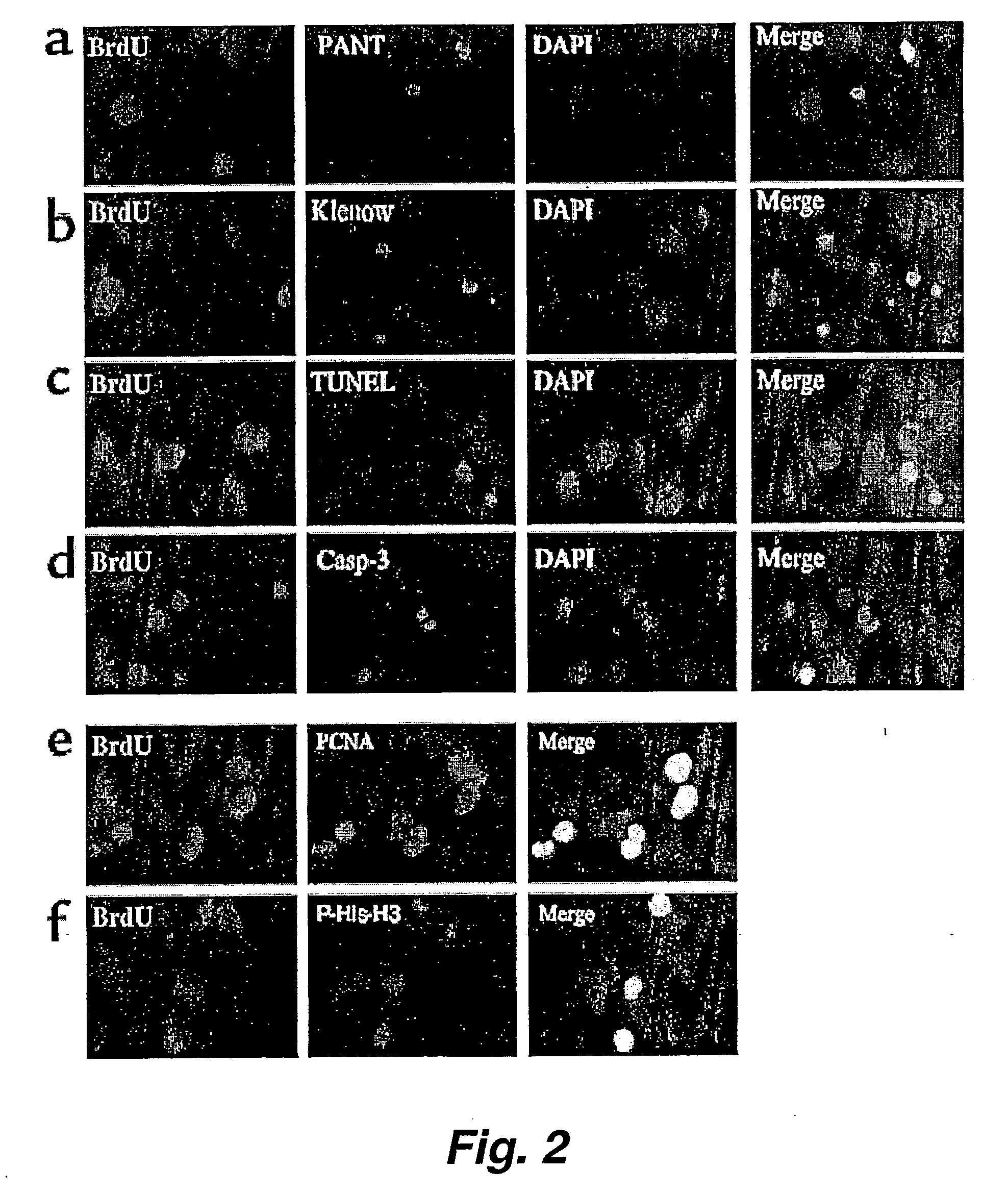Neurogenerative or neurotrophic factors for mitigating a symptom of ischemia
a neurotrophic factor and ischemia technology, applied in the field of neurology, can solve the problems of elusive wide-effect stroke treatment, local tissue damage or stroke, intracerebral neural precursor cell transplantation, etc., and achieve the effect of increasing the stability and half-life of such molecules and facilitating the addition of additional moieties
- Summary
- Abstract
- Description
- Claims
- Application Information
AI Technical Summary
Benefits of technology
Problems solved by technology
Method used
Image
Examples
example 1
Stem Cell Factor Stimulates Neurogenesis In Vitro and In Vivo
[0184] Cerebral ischemia stimulates neurogenesis in proliferative zones of the rodent forebrain. In this example, to identify the signaling factors involved, cerebral cortical cultures prepared from embryonic mouse brains were deprived of oxygen. Hypoxia increased bromodeoxyuridine (BrdU) incorporation into cells that expressed proliferation markers and immature neuronal markers and that lacked evidence of DNA damage or caspase-3 activation. Hypoxia-conditioned medium and stem cell factor (SCF), which was present in hypoxia-conditioned medium at increased levels, also stimulated BrdU incorporation into normoxic cultures. The SCF receptor, c-kit, was expressed in neuronal cultures and in neuroproliferative zones of the adult rat brain, and in vivo administration of SCF increased BrdU labeling of immature neurons in these regions. Cerebral hypoxia and ischemia may stimulate neurogenesis through trophic factors, including SC...
example 2
1. Adult Neurogenesis In Vivo
[0239] a) Increasing BrdU Incorporation into DG and SVZ after Ischemia
[0240] Because neurogenesis persists in the adult mammalian brain and can be regulated by physiological and pathological events, we investigated its possible involvement in the brain's response to focal cerebral ischemia. Ischemia was induced by occlusion of the middle cerebral artery in the rat for 90 min, and proliferating cells were labeled with BrdU over 2-day periods prior to sacrificing animals 1, 2 or 3 week after ischemia. The brain regions examined for BrdU incorporation included Û SGZ and SVZ Û. We confirmed that neurogenesis occurs in these regions in normal rat brains. When brains of postischemic animals were stained for BrdU, there was increased labeling in the SGZ and SVZ. In the SGZ, more cells were labeled ipsilateral than contralateral to ischemia at 1 week. The labeled cells were irregularly distributed immediately subjacent to the DG granule cell layer. In the SVZ...
example 3
Cerebral Neurogenesis Induced by Intranasal Administration of Growth Factors
[0261] Neurogenesis, which is critical in brain development and continues into adulthood, can be stimulated by injury and may have a role in brain repair and associated functional recovery. Therefore, the ability to augment injury-induced neurogenesis could have therapeutic consequences for acute and chronic neurodegenerative disease. Growth factors, usually given by the intracerebroventricular route, are among the best characterized stimuli to neurogenesis in rodents, but their clinical usefulness is restricted by their limited access to the brain after systemic administration. Based on reports that growth factors can enter the brain after intranasal delivery, we investigated the effects of two such factors, fibroblast growth factor-2 (FGF-2) and heparin-binding epidermal growth factor-like growth factor (HB-EGF), on neurogenesis in the principal neuroproliferative regions of the adult mouse brain—the rost...
PUM
| Property | Measurement | Unit |
|---|---|---|
| Tm | aaaaa | aaaaa |
| concentrations | aaaaa | aaaaa |
| concentrations | aaaaa | aaaaa |
Abstract
Description
Claims
Application Information
 Login to View More
Login to View More - R&D
- Intellectual Property
- Life Sciences
- Materials
- Tech Scout
- Unparalleled Data Quality
- Higher Quality Content
- 60% Fewer Hallucinations
Browse by: Latest US Patents, China's latest patents, Technical Efficacy Thesaurus, Application Domain, Technology Topic, Popular Technical Reports.
© 2025 PatSnap. All rights reserved.Legal|Privacy policy|Modern Slavery Act Transparency Statement|Sitemap|About US| Contact US: help@patsnap.com



